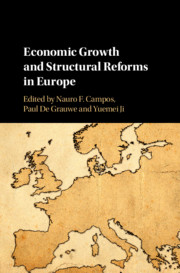Book contents
- Economic Growth and Structural Reforms in Europe
- Economic Growth and Structural Reforms in Europe
- Copyright page
- Contents
- Figures
- Tables
- Contributors
- Introduction
- Part I Economic Growth and Structural Reforms in Europe
- 1 Euro Area Growth and European Institutional Reforms
- 2 Structural Reforms and Growth
- 3 Regulation, Institutions and Economic Growth in Advanced, Emerging and Developing Countries
- Part II Macroeconomic Implications of Reforms
- Part III Case Studies
- Conclusions
- Index
- References
1 - Euro Area Growth and European Institutional Reforms
from Part I - Economic Growth and Structural Reforms in Europe
Published online by Cambridge University Press: 31 March 2020
- Economic Growth and Structural Reforms in Europe
- Economic Growth and Structural Reforms in Europe
- Copyright page
- Contents
- Figures
- Tables
- Contributors
- Introduction
- Part I Economic Growth and Structural Reforms in Europe
- 1 Euro Area Growth and European Institutional Reforms
- 2 Structural Reforms and Growth
- 3 Regulation, Institutions and Economic Growth in Advanced, Emerging and Developing Countries
- Part II Macroeconomic Implications of Reforms
- Part III Case Studies
- Conclusions
- Index
- References
Summary
Euro area countries have experienced profound economic, financial and institutional changes over the last three decades. GDP growth has been very volatile, and very uneven, across countries. Which factors played a role in stirring growth and/or reducing it?We provide an atheoretical toolkit looking at a large set of real, financial, monetary and institutional variables, as possible factors behind fluctuations and differences in growth rates among euro area countries since 1990. The main outcome stresses the key positive role for long-run growth of higher European institutional integration, overall and for the periphery in specific. This result is robust across specifications and setups. If we split the European institutional integration into its main components, we can see a significant positive role for financial and political integration in the long run. However, the first seems to have beneficial effects for the core only, while the opposite holds for the political integration, which influences positively the periphery.
Keywords
- Type
- Chapter
- Information
- Economic Growth and Structural Reforms in Europe , pp. 9 - 36Publisher: Cambridge University PressPrint publication year: 2020
References
- 1
- Cited by



